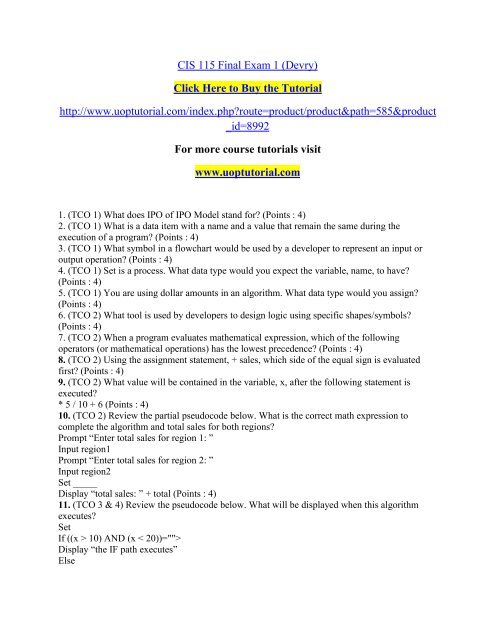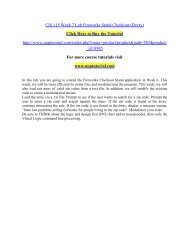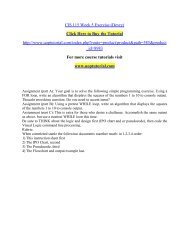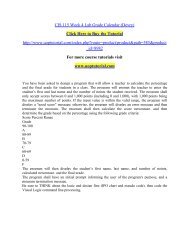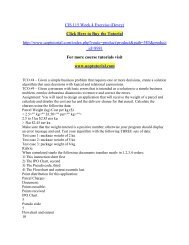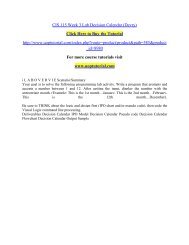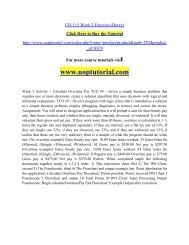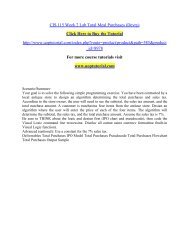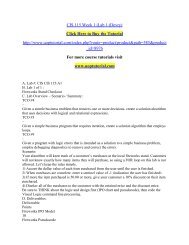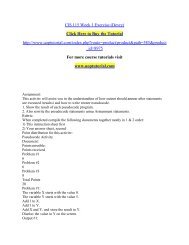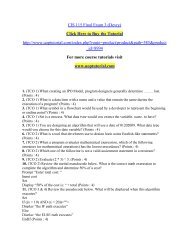CIS 115 Final Exam 1
For more course tutorials visit www.uoptutorial.com CIS 115 Entire Course: Devry University: All iLabs and Exercises
For more course tutorials visit
www.uoptutorial.com
CIS 115 Entire Course: Devry University: All iLabs and Exercises
- No tags were found...
You also want an ePaper? Increase the reach of your titles
YUMPU automatically turns print PDFs into web optimized ePapers that Google loves.
<strong>CIS</strong> <strong>115</strong> <strong>Final</strong> <strong>Exam</strong> 1 (Devry)<br />
Click Here to Buy the Tutorial<br />
http://www.uoptutorial.com/index.php?route=product/product&path=585&product<br />
_id=8992<br />
For more course tutorials visit<br />
www.uoptutorial.com<br />
1. (TCO 1) What does IPO of IPO Model stand for? (Points : 4)<br />
2. (TCO 1) What is a data item with a name and a value that remain the same during the<br />
execution of a program? (Points : 4)<br />
3. (TCO 1) What symbol in a flowchart would be used by a developer to represent an input or<br />
output operation? (Points : 4)<br />
4. (TCO 1) Set is a process. What data type would you expect the variable, name, to have?<br />
(Points : 4)<br />
5. (TCO 1) You are using dollar amounts in an algorithm. What data type would you assign?<br />
(Points : 4)<br />
6. (TCO 2) What tool is used by developers to design logic using specific shapes/symbols?<br />
(Points : 4)<br />
7. (TCO 2) When a program evaluates mathematical expression, which of the following<br />
operators (or mathematical operations) has the lowest precedence? (Points : 4)<br />
8. (TCO 2) Using the assignment statement, + sales, which side of the equal sign is evaluated<br />
first? (Points : 4)<br />
9. (TCO 2) What value will be contained in the variable, x, after the following statement is<br />
executed?<br />
* 5 / 10 + 6 (Points : 4)<br />
10. (TCO 2) Review the partial pseudocode below. What is the correct math expression to<br />
complete the algorithm and total sales for both regions?<br />
Prompt “Enter total sales for region 1: ”<br />
Input region1<br />
Prompt “Enter total sales for region 2: ”<br />
Input region2<br />
Set _____<br />
Display “total sales: ” + total (Points : 4)<br />
11. (TCO 3 & 4) Review the pseudocode below. What will be displayed when this algorithm<br />
executes?<br />
Set<br />
If ((x > 10) AND (x < 20))=""><br />
Display “the IF path executes”<br />
Else
Display “the ELSE path executes”<br />
EndIf (Points : 4)<br />
12. (TCO 3 & 4) What value gets displayed for the variable X?<br />
Set<br />
Set<br />
Set<br />
If (B > 15) AND (() OR (C <br />
Set<br />
Else<br />
Set<br />
EndIf<br />
Display X (Points : 4)<br />
13. (TCO 3 & 4) In the following pseudocode, what raise will an employee in Department 6<br />
receive?<br />
If department < 2=""><br />
Set<br />
Else<br />
If department < 6=""><br />
Set<br />
Else<br />
Set<br />
EndIf<br />
EndIf (Points : 4)<br />
14. (TCO 3 & 4) Which of the selection structures determines if the user enters a number<br />
between 20 and 45? (Points : 4)<br />
15. (TCO 3 & 4) What value gets displayed for the variable Z?<br />
Set<br />
Set<br />
Set<br />
If ((balance 800) OR (stateCode 6) OR (creditCode 7) then<br />
Set<br />
Else<br />
Set<br />
EndIf<br />
Display Z (Points : 4)<br />
1. (TCO 5) The variable used to create an expression controlling the loop is known as the _____.<br />
(Points : 4)<br />
2. (TCO 5) Which of the following statements is false? (Points : 4)<br />
3. (TCO 5) Which control structure is classified as a loop? (Points : 4)<br />
4. (TCO 5) Repetition that loops a certain number of times is typically referred to as _____.<br />
(Points : 4)<br />
5. (TCO 5) How many times will the following loop be executed?<br />
Set<br />
DOWHILE x 7<br />
Display x
Set + 1<br />
ENDO (Points : 4)<br />
6. (TCO 7) What is a subscript or an index? (Points : 4)<br />
7. (TCO 7) Suppose you have an array named number and two of its elements are number(1) and<br />
number(4). You know that _____. (Points : 4)<br />
8. (TCO 7) What is the value of the index used to access the last element in a zero-based array<br />
declared as num(12)? (Points : 4)<br />
9. (TCO 7) When loading/initializing the elements of an array, what control structure is used to<br />
move through each element within the array? (Points : 4)<br />
10. (TCO 7) A zero-based array named sales has been declared and loaded with the values: 100,<br />
1100, 3400, 5550, 3000, 22300, 1200. What value will be stored in the array element, sales(2)?<br />
(Points : 4)<br />
11. (TCO 6) A record contains _____. (Points : 4)<br />
12. (TCO 6) What are the three modes of operation on a file? (Points : 4)<br />
13. (TCO 8) Many algorithms require direct communication from users. These types of<br />
algorithms are called _____. (Points : 4)<br />
14. (TCO 9) What type of error occurs when an array subscript’s value goes beyond the total<br />
number of elements in the array? (Points : 4)<br />
15. (TCO 2) What type of variable can be accessed by any module within the design? (Points : 4)<br />
1. (TCO 10) A department store is having a customer appreciation sale. Depending on the total<br />
dollars purchased, the customer could receive a discount on total purchases. You are to develop<br />
pseudocode that will obtain the total dollars purchased from the user, determine the discount<br />
percent, and display the total amount due. When the purchases are more than $500, the discount<br />
is 10%. When the purchases are $500 or less, the discount is 6%. (Points : 10)<br />
2. (TCO 10) A small business in your neighborhood would like an application developed that<br />
determines the average dollar amount spent for every three purchases. The user will enter three<br />
different purchase amounts. You need to display the average to your client. Complete the<br />
pseudocode to design your logic. (Points : 10)<br />
3. (TCO 9 & 10) There is a logic error in the following pseudocode. What statement(s) would<br />
you need to add to correct the logic? Be sure to explain why you are adding the statements.<br />
Set<br />
DOWHILE num<br />
Set + num<br />
ENDO<br />
Display total (Points : 10)<br />
4. (TCO 4 & 10) Complete the pseudocode by rewriting the algorithm. The design is determining<br />
the correct sales tax depending on the county identifying code. Counties with a number less than<br />
7 have a 5% sales tax. The 8-24 codes have a sales tax of 7%. Codes above 24 have a sales tax of<br />
9%. The code is entered by the user.<br />
Begin<br />
Declare Real salesTax<br />
Declare ____ countyCode<br />
_____ “Enter the county code: “<br />
Input _____________<br />
If _______ <br />
Set
Else<br />
If ______ AND ______ then<br />
______________<br />
Else<br />
Set<br />
EndIf<br />
____________<br />
Display “the sales tax is: “ + _______________<br />
End (Points : 10)<br />
5. (TCO 5 & 10) Complete the pseudocode by rewriting the algorithm. The design is to display a<br />
60 second countdown.<br />
Begin<br />
Declare _______ count<br />
Set<br />
REPEAT<br />
Display “countdown: “ + _______<br />
Set - 1<br />
UNTIL ___________<br />
Display “LIFT OFF!”<br />
End (Points : 10)<br />
6. (TCO 4, 5 & 10) Complete the pseudocode by rewriting the algorithm. The colors red, blue,<br />
and yellow are known as primary colors because they cannot be made by mixing other colors.<br />
When you mix two primary colors, you get a secondary color. Mixing yellow and blue gets you<br />
green. Mixing red and blue gets you purple. The algorithm allows the user to enter two primary<br />
colors and then displays the resulting secondary color. The colors entered by the user will be<br />
validated to ensure they entered a primary color.<br />
Begin<br />
Declare String color1<br />
Declare String color2<br />
Declare String control1<br />
Declare String control2<br />
______ “Enter first primary color: “<br />
Input _______<br />
Prompt “Enter the second primary color: “<br />
Input _________<br />
Set control1 = “n”<br />
DOWHILE control1 = “n”<br />
If (color1 “yellow”) ______ (color1 “red”) _______ (color1 “blue”) then<br />
Prompt “first primary color is invalid”<br />
Input _________<br />
Else<br />
Set control1 = “y”<br />
ENDO<br />
Set control2 = “n”<br />
DOWHILE control2 = “n”<br />
If (color2 “yellow”) ______ (color2 “red”) _______ (color2 “blue”) then
Prompt “second primary color is invalid”<br />
Input color2<br />
Else<br />
Set control2 = “y”<br />
ENDO<br />
If (color1 = “red”) AND (__________) then<br />
Display “secondary color is: purple”<br />
EndIf<br />
If (color1 = “yellow”) AND (_________) then<br />
Display “secondary color is: green”<br />
EndIf<br />
End (Points : 10)<br />
7. (TCO 1, 2, 3, & 4) Describe the difference between a flowchart and pseudocode and explain<br />
whether one is more important to develop than the other. (Points : 10)<br />
8. (TCO 1, 2, 3, 4, & 5) Compare and contrast sequence control structures and selection control<br />
structures. (Points : 10)


